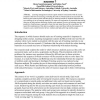868 search results - page 30 / 174 » Learning Object Representations Using Sequential Patterns |
CORR
2002
Springer
13 years 7 months ago
2002
Springer
for data abstraction and justifies reasoning by simulation. Representation independence has been shown for a variety of languages and constructs but not for shared references to mu...
ICCV
2005
IEEE
14 years 9 months ago
2005
IEEE
Object tracking is a challenging problems in real-time computer vision due to variations of lighting condition, pose, scale, and view-point over time. However, it is exceptionally...
ICML
2007
IEEE
14 years 8 months ago
2007
IEEE
The k-Nearest Neighbors algorithm can be easily adapted to classify complex objects (e.g. sets, graphs) as long as a proper dissimilarity function is given over an input space. Bo...
SIGMOD
2009
ACM
14 years 7 months ago
2009
ACM
Composite (or Complex) event processing (CEP) systems search sequences of incoming events for occurrences of userspecified event patterns. Recently, they have gained more attentio...
EDM
2010
13 years 9 months ago
2010
Learning management systems capture student's interactions with the course contents in the form of event logs, including the order in which resources are accessed. We build on...

